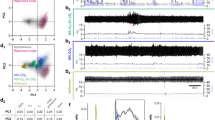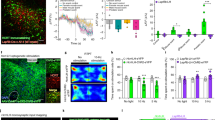Abstract
The parabrachial nucleus (PBN) integrates interoceptive and exteroceptive information to control various behavioral and physiological processes including breathing, emotion, and sleep/wake regulation through the neural circuits that connect to the forebrain and the brainstem. However, the precise identity and function of distinct PBN subpopulations are still largely unknown. Here, we leveraged molecular characterization, retrograde tracing, optogenetics, chemogenetics, and electrocortical recording approaches to identify a small subpopulation of neurotensin-expressing neurons in the PBN that largely project to the emotional control regions in the forebrain, rather than the medulla. Their activation induces freezing and anxiety-like behaviors, which in turn result in tachypnea. In addition, optogenetic and chemogenetic manipulations of these neurons revealed their function in promoting wakefulness and maintaining sleep architecture. We propose that these neurons comprise a PBN subpopulation with specific gene expression, connectivity, and function, which play essential roles in behavioral and physiological regulation.






Similar content being viewed by others
References
Chiang MC, Bowen A, Schier LA, Tupone D, Uddin O, Heinricher MM. Parabrachial complex: a hub for pain and aversion. J Neurosci 2019, 39: 8225–8230.
Fu O, Iwai Y, Kondoh K, Misaka T, Minokoshi Y, Nakajima KI. SatB2-expressing neurons in the parabrachial nucleus encode sweet taste. Cell Rep 2019, 27: 1650–1656.
Jarvie BC, Chen JY, King HO, Palmiter RD. Satb2 neurons in the parabrachial nucleus mediate taste perception. Nat Commun 2021, 12: 224.
Bowen AJ, Chen JY, Huang YW, Baertsch NA, Park S, Palmiter RD. Dissociable control of unconditioned responses and associative fear learning by parabrachial CGRP neurons. eLife 2020, 9: e59799.
Han S, Soleiman MT, Soden ME, Zweifel LS, Palmiter RD. Elucidating an affective pain circuit that creates a threat memory. Cell 2015, 162: 363–374.
Geerling JC, Kim M, Mahoney CE, Abbott SBG, Agostinelli LJ, Garfield AS. Genetic identity of thermosensory relay neurons in the lateral parabrachial nucleus. Am J Physiol Regul Integr Comp Physiol 2016, 310: R41–R54.
Palmiter RD. The parabrachial nucleus: CGRP neurons function as a general alarm. Trends Neurosci 2018, 41: 280–293.
Yokota S, Kaur S, VanderHorst VG, Saper CB, Chamberlin NL. Respiratory-related outputs of glutamatergic, hypercapnia-responsive parabrachial neurons in mice. J Comp Neurol 2015, 523: 907–920.
Kaur S, Wang JL, Ferrari L, Thankachan S, Kroeger D, Venner A, et al. A genetically defined circuit for arousal from sleep during hypercapnia. Neuron 2017, 96: 1153–1167.
Fulwiler CE, Saper CB. Subnuclear organization of the efferent connections of the parabrachial nucleus in the rat. Brain Res Rev 1984, 7: 229–259.
Bianchi R, Corsetti G, Rodella L, Tredici G, Gioia M. Supraspinal connections and termination patterns of the parabrachial complex determined by the biocytin anterograde tract-tracing technique in the rat. J Anat 1998, 193(Pt 3): 417–430.
Dutschmann M, Dick TE. Pontine mechanisms of respiratory control. Compr Physiol 2012, 2: 2443–2469.
Ryan PJ, Ross SI, Campos CA, Derkach VA, Palmiter RD. Oxytocin-receptor-expressing neurons in the parabrachial nucleus regulate fluid intake. Nat Neurosci 2017, 20: 1722–1733.
Mu D, Deng J, Liu KF, Wu ZY, Shi YF, Guo WM, et al. A central neural circuit for itch sensation. Science 2017, 357: 695–699.
Yu H, Shi L, Chen J, Jun S, Hao Y, Wang S, et al. A neural circuit mechanism controlling breathing by leptin in the nucleus tractus solitarii. Neurosci Bull 2022, 38: 149–165.
Liu S, Kim DI, Oh TG, Pao GM, Kim JH, Palmiter RD, et al. Neural basis of opioid-induced respiratory depression and its rescue. Proc Natl Acad Sci U S A 2021, 118: e2022134118.
Liu S, Ye M, Pao GM, Song SM, Jhang J, Jiang H, et al. Divergent brainstem opioidergic pathways that coordinate breathing with pain and emotions. Neuron 2022, 110: 857–873.
Rodriguez E, Ryu D, Zhao S, Han BX, Wang F. Identifying parabrachial neurons selectively regulating satiety for highly palatable food in mice. eNeuro 2019, 6: ENEURO.0252–ENEURO.0219.2019.
Campos CA, Bowen AJ, Roman CW, Palmiter RD. Encoding of danger by parabrachial CGRP neurons. Nature 2018, 555: 617–622.
Lein ES, Hawrylycz MJ, Ao N, Ayres M, Bensinger A, Bernard A, et al. Genome-wide atlas of gene expression in the adult mouse brain. Nature 2007, 445: 168–176.
Schroeder LE, Leinninger GM. Role of central neurotensin in regulating feeding: Implications for the development and treatment of body weight disorders. Biochim Biophys Acta BBA Mol Basis Dis 2018, 1864: 900–916.
Cape EG, Manns ID, Alonso A, Beaudet A, Jones BE. Neurotensin-induced bursting of cholinergic basal forebrain neurons promotes gamma and theta cortical activity together with waking and paradoxical sleep. J Neurosci 2000, 20: 8452–8461.
van Wimersma Greidanus TB, Schijff JA, Noteboom JL, Spit MC, Bruins L, van Zummeren M, et al. Neurotensin and bombesin, a relationship between their effects on body temperature and locomotor activity? Pharmacol Biochem Behav 1984, 21: 197–202.
Russjan E, Kaczyńska K. Beneficial effects of neurotensin in murine model of hapten-induced asthma. Int J Mol Sci 2019, 20: 5025.
Morin-Surun MP, Marlot D, Kessler JP, Denavit-Saubie M. The excitation by neurotensin of nucleus tractus solitarius neurons induces apneustic breathing. Brain Res 1986, 384: 106–113.
Kashiwagi M, Kanuka M, Tatsuzawa C, Suzuki H, Morita M, Tanaka K, et al. Widely distributed neurotensinergic neurons in the brainstem regulate NREM sleep in mice. Curr Biol 2020, 30: 1002–1010.
Ma C, Zhong P, Liu D, Barger ZK, Zhou L, Chang WC, et al. Sleep regulation by neurotensinergic neurons in a thalamo-amygdala circuit. Neuron 2019, 103: 323–334.
Normandeau CP, Ventura-Silva AP, Hawken ER, Angelis S, Sjaarda C, Liu X, et al. A key role for neurotensin in chronic-stress-induced anxiety-like behavior in rats. Neuropsychopharmacology 2018, 43: 285–293.
Zhong P, Zhang Z, Barger Z, Ma C, Liu D, Ding X, et al. Control of non-REM sleep by midbrain neurotensinergic neurons. Neuron 2019, 104: 795–809.
Leinninger GM, Opland DM, Jo YH, Faouzi M, Christensen L, Cappellucci LA, et al. Leptin action via neurotensin neurons controls orexin, the mesolimbic dopamine system and energy balance. Cell Metab 2011, 14: 313–323.
Madisen L, Zwingman TA, Sunkin SM, Oh SW, Zariwala HA, Gu H, et al. A robust and high-throughput Cre reporting and characterization system for the whole mouse brain. Nat Neurosci 2010, 13: 133–140.
Li P, Li SB, Wang X, Phillips CD, Schwarz LA, Luo L, et al. Brain circuit of claustrophobia-like behavior in mice identified by upstream tracing of sighing. Cell Rep 2020, 31: 107779.
Zhang C, Li H, Han R. An open-source video tracking system for mouse locomotor activity analysis. BMC Res Notes 2020, 13: 48.
Oishi Y, Takata Y, Taguchi Y, Kohtoh S, Urade Y, Lazarus M. Polygraphic recording procedure for measuring sleep in mice. J Vis Exp 2016: e53678.
Bachmutsky I, Wei XP, Kish E, Yackle K. Opioids depress breathing through two small brainstem sites. eLife 2020, 9: e52694.
Jiang M, Alheid GF, Calandriello T, McCrimmon DR. Parabrachial-lateral pontine neurons link nociception and breathing. Respir Physiol Neurobiol 2004, 143: 215–233.
Ezure K. Respiration-related afferents to parabrachial pontine regions. Respir Physiol Neurobiol 2004, 143: 167–175.
Song G, Yu Y, Poon CS. Cytoarchitecture of pneumotaxic integration of respiratory and nonrespiratory information in the rat. J Neurosci 2006, 26: 300–310.
Li P, Janczewski WA, Yackle K, Kam K, Pagliardini S, Krasnow MA, et al. The peptidergic control circuit for sighing. Nature 2016, 530: 293–297.
Li P, Yackle K. Sighing. Curr Biol 2017, 27: R88–R89.
Gross CT, Canteras NS. The many paths to fear. Nat Rev Neurosci 2012, 13: 651–658.
Marcinkiewcz CA, Mazzone CM, D’Agostino G, Halladay LR, Hardaway JA, DiBerto JF, et al. Serotonin engages an anxiety and fear-promoting circuit in the extended amygdala. Nature 2016, 537: 97–101.
Fadok JP, Krabbe S, Markovic M, Courtin J, Xu C, Massi L, et al. A competitive inhibitory circuit for selection of active and passive fear responses. Nature 2017, 542: 96–100.
Goode TD, Ressler RL, Acca GM, Miles OW, Maren S. Bed nucleus of the stria terminalis regulates fear to unpredictable threat signals. eLife 2019, 8: e46525.
Smith JC, Ellenberger HH, Ballanyi K, Richter DW, Feldman JL. Pre-Bötzinger complex: a brainstem region that may generate respiratory rhythm in mammals. Science 1991, 254: 726–729.
Naganuma F, Kroeger D, Bandaru SS, Absi G, Madara JC, Vetrivelan R. Lateral hypothalamic neurotensin neurons promote arousal and hyperthermia. PLoS Biol 2019, 17: e3000172.
Gilpin NW, Herman MA, Roberto M. The central amygdala as an integrative hub for anxiety and alcohol use disorders. Biol Psychiatry 2015, 77: 859–869.
Cai YQ, Wang W, Paulucci-Holthauzen A, Pan ZZ. Brain circuits mediating opposing effects on emotion and pain. J Neurosci 2018, 38: 6340–6349.
Kaur S, Pedersen NP, Yokota S, Hur EE, Fuller PM, Lazarus M, et al. Glutamatergic signaling from the parabrachial nucleus plays a critical role in hypercapnic arousal. J Neurosci 2013, 33: 7627–7640.
Cano G, Mochizuki T, Saper CB. Neural circuitry of stress-induced insomnia in rats. J Neurosci 2008, 28: 10167–10184.
Wulff K, Gatti S, Wettstein JG, Foster RG. Sleep and circadian rhythm disruption in psychiatric and neurodegenerative disease. Nat Rev Neurosci 2010, 11: 589–599.
Khazaie H, Ghadami MR, Masoudi M. Sleep disturbances in veterans with chronic war-induced PTSD. J Inj Violence Res 2016, 8: 99–107.
Acknowledgements
We thank Dr. Giancarlo Vanini for advice on the EEG/EMG implantation surgery, and Dr. Roger Cone for the setups for elevated plus maze and open field test. We also thank Dr. Xuenan Wang for her help with EEG/EMG data analysis. This work was supported by the University of Michigan startup funds and the NIH Grants R01 AT011652 and R01 HL156989.
Author information
Authors and Affiliations
Corresponding author
Ethics declarations
Conflict of interest
The authors claim that there are no conflicts of interest.
Supplementary Information
Below is the link to the electronic supplementary material.
Supplementary file1 (MP4 27545 kb)
Rights and permissions
Springer Nature or its licensor (e.g. a society or other partner) holds exclusive rights to this article under a publishing agreement with the author(s) or other rightsholder(s); author self-archiving of the accepted manuscript version of this article is solely governed by the terms of such publishing agreement and applicable law.
About this article
Cite this article
Chen, J., Gannot, N., Li, X. et al. Control of Emotion and Wakefulness by Neurotensinergic Neurons in the Parabrachial Nucleus. Neurosci. Bull. 39, 589–601 (2023). https://doi.org/10.1007/s12264-022-00994-8
Received:
Accepted:
Published:
Issue Date:
DOI: https://doi.org/10.1007/s12264-022-00994-8




